Guadeloupe amazon
| Guadeloupe amazon | |
|---|---|
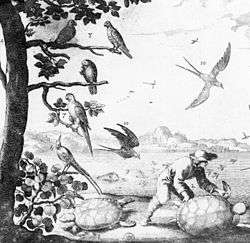 | |
| Du Tetre's 1667 illustration of three Guadeloupe amazons (8) and one Lesser Antillean macaw (7) | |
| Scientific classification | |
| Kingdom: | Animalia |
| Phylum: | Chordata |
| Class: | Aves |
| Order: | Psittaciformes |
| Superfamily: | Psittacoidea |
| Family: | Psittacidae |
| Subfamily: | Arinae |
| Tribe: | Androglossini |
| Genus: | Amazona |
| Species: | † A. violacea |
| Binomial name | |
| † Amazona violacea (Gmelin, 1789) | |
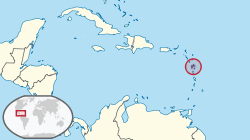 | |
| Location of Guadeloupe | |
| Synonyms | |
|
List
| |
The Guadeloupe amazon or Guadeloupe parrot (Amazona violacea) is a hypothetical extinct species of parrot in the family Psittacidae. It was endemic to Guadeloupe. It was hunted, and by 1779 was already rare. Today it is extinct.
Taxonomy
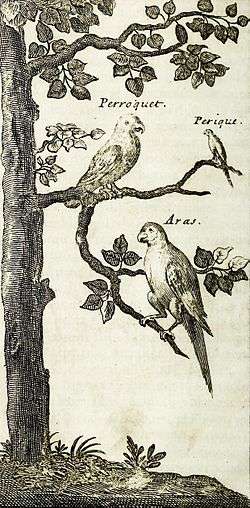
The Guadeloupe amazon was first mentioned by Jean-Baptiste Du Tertre in 1664 and Jean-Baptiste Labat.[2][3][4]
The description has led to restorations – mostly based on literal interpretation of the old descriptions – but altogether the sources indicate a bird with the general color pattern of the imperial amazon (A. imperialis) of Dominica, the next major island south of Guadeloupe.[5] Storrs Olson and Edgar Maíz consider "A. violacea" as probably identical to the living species.[6]
A bone found on Marie-Galante – between Dominica and Guadeloupe – has been assigned to A. violacea; this may be taken to suggest that A. imperialis inhabited and/or was traded between all three islands in prehistoric times.[6][7][8]
The violet macaw (Anodorhynchus purpurascens) was described by Rothschild and featured in his book, Extinct Birds published in 1907.[9] Its native name was supposedly oné couli. Rothschild named the species because uniform bluish coloured macaws were said to have inhabited the island of Guadeloupe,[9] but the recent tracing of the sources used by Rothschild has evidenced the author based on a poor depiction of the Guadeloupe Amazon by Raymond Breton, a French missionary present in Guadeloupe during the first years of the French colonization.[10] Only the genus Ara is thus known to have colonised the West Indies.[5]
Description
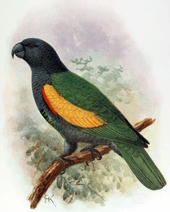
Du Tertre described it as follows in 1667:
He is about as big as a fowl, has the beak and eyes bordered with red. All the feathers of the head, neck and belly are of a violet colour, a little mixed with black and green, shot like the throat of a pigeon. All the upper part of the back is green, strongly washed with brown. Outer primaries black, rest yellow, green and red.[11]
Labat described the bird as follows in 1742:
Those of Guadaloupe are a little smaller than the Aras; they have the head, the neck, and the belly slate colour with a few green and black feathers, the back is entirely green, and the wings are yellow and red.[11]
Behaviour and ecology
Du Tetre described some details of their breeding behaviour:
We had two which built their nest a hundred paces from our house in a large tree. The male and the female sat alternately, and came one after the other to feed at the house, where they brought their young when they were large enough to leave the nest.[2]
Extinction
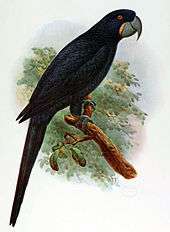
Guadeloupe is less mountainous than Dominica, and the human population was larger, which would have led to a larger pressure on the Guadeloupe amazon than the one on Dominica. The Guadeloupe amazon appears to have gone extinct by the end of the 18th century.[5] In 1779, Buffon stated the bird had become very rare, and perhaps extinct:
We have never seen this parrot, and it is not found on Cayenne. It is even rare in Guadeloupe to-day, for none of the inhabitants of the island have given us any information concerning it;[2]
References
- ↑ BirdLife International (2012). "Amazona violacea". IUCN Red List of Threatened Species. Version 2013.2. International Union for Conservation of Nature. Retrieved 26 November 2013.
- 1 2 3 Clark, A. H. (1905). "The West Indian Parrots". The Auk. 22 (4): 337–344. doi:10.2307/4069996. JSTOR 4069996.
- ↑ Latham, J.; Chanler, R. W. (1821). "A General History of Birds". doi:10.5962/bhl.title.62572.
- ↑ Greenway, J. C. (1967). Extinct and Vanishing Birds of the World. New York: American Committee for International Wild Life Protection 13. pp. 328–331. ISBN 0-486-21869-4.
- 1 2 3 Hume, J. P.; Walters, M. (2012). Extinct Birds. London: A & C Black. pp. 338–339. ISBN 1-4081-5725-X.
- 1 2 Olson, S. L.; E. J. Máiz López (2008). "New evidence of Ara autochthones from an archeological site in Puerto Rico: a valid species of West Indian macaw of unknown geographical origin (Aves: Psittacidae)" (pdf). Caribbean Journal of Science. 44 (2): 215–222.
- ↑ Williams, M. I.; D. W. Steadman (2001). "The historic and prehistoric distribution of parrots (Psittacidae) in the West Indies". In Woods, Charles A.; Florence E. Sergile. Biogeography of the West Indies: Patterns and Perspectives (pdf) (2nd ed.). Boca Raton, Florida: CRC Press. pp. 175–189. ISBN 0-8493-2001-1.
- ↑ Ridgway, Robert; Friedmann, Herbert (1916). The Birds of North and Middle America. Washington, DC, US: Smithsonian Institution. p. 224. LCCN 11035036.
- 1 2 Rothschild, Walter (1907). Extinct Birds. Hutchison, London.
- ↑ Lenoble, A. (2015). "The Violet Macaw (Anodorhynchus purpurascens Rothschild, 1905) did not exist". Journal of Caribbean Ornithology. 28: 17–21.
- 1 2 Rothschild, W. (1907). Extinct Birds. London: Hutchinson & Co. p. 57.
